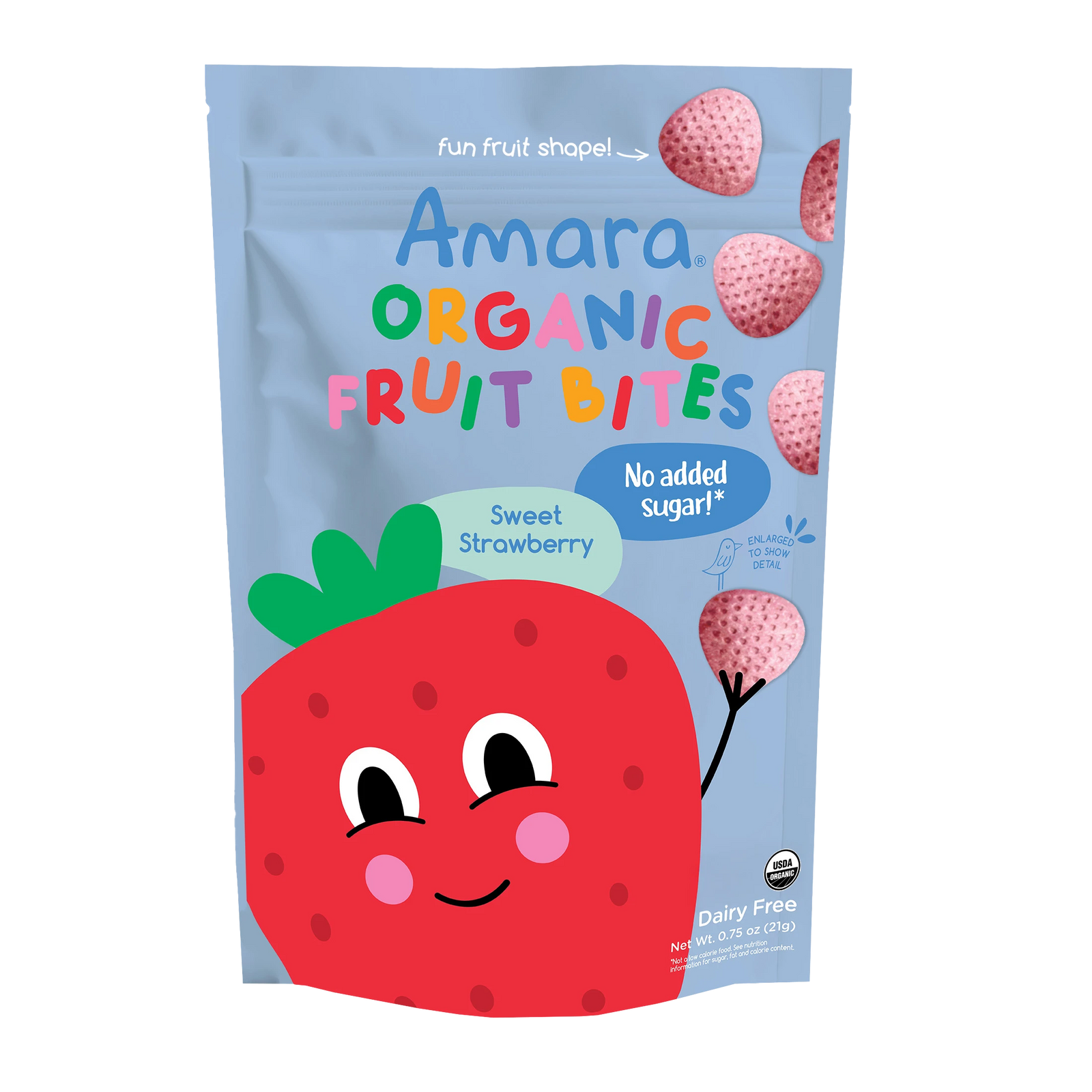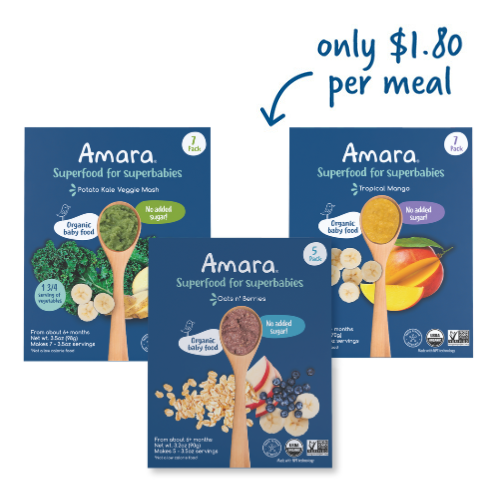
If you’re a mom with a child under the age of ten, we’re guessing you’ve probably heard of baby-led weaning. “BLW” (as all the cool kids call it) was originally devised as an alternative to spoon-feeding for starting babies on solid foods (as in, “do this not that”)... but we’re here to tell you that the two approaches aren’t incompatible. In fact, they complement one another quite nicely.
Here’s everything you need to know about BLW -- you can skip ahead to learn more about:
What do we know about baby-led weaning?
What are the pros and cons of baby-led weaning?
What’s the takeaway on baby-led weaning?
What is Baby-Led Weaning?
The entire premise behind BLW isself-feeding. Whereas with spoon-feeding, parents are doing the feeding, with BLW, it’s babies who are feeding themselves. Thus, even though it’s the parent who is choosing/offering the foods, it’s the baby who is actually in control of everything else. With BLW, baby decides whether/what to eat (from what’s offered), how quickly to eat, and how much to eat.
It may sound obvious, but this approach implicitly grants babies a more active role in feeding. To use a cliche, it puts them in the driver’s seat.
There are two other mainstays you should know about that come part and parcel with “true adherence” (hah) to BLW:
1) babies participate in shared family meals (vs. mealtimes where babies eat “alone” with a caretaker/parent feeding them)
2) they’re offered whole foods.
It’s possible to interpret each of these three main features -- self-feeding, shared meals, and a whole foods diet -- as advantageous or disadvantageous, depending on both your take and your goals. (Some parents see BLW as imminently more convenient, for example, because there is no extensive food prep or pureeing, while others see it asinconvenient because it doesn’t allow for pureed infant foods. See what I mean?)
We’ll dig into all this shortly, but first, let’s consider:
What Do We Know About Baby-Led Weaning?
The unfortunate reality is that there is not very much research on BLW -- and what research does exist is not exactly ideal. Many projects use conflicting and/or unclear definitions of BLW, for example, which makes it difficult to compare notes. Some studies are forced to rely on more “fragile” data, such as self-reporting or internet accounts, which can be prone to inaccuracies. And across the board, studies attempting to critically assess BLW as a feeding strategy are riddled with confounding factors: moms who opt to follow BLW are more likely to be more highly educated, more likely to have secure, professional employment, and more likely to breastfeed (and for longer).
The research is, to be frank, incomplete -- and perhaps more than anything else it shows us that we don’t really have a clear consensus as to whatexactly constitutes BLW or what it’s most salient elements are, nevermind its exact upshots.
The point is: if you were hoping that evidence would offer a clear answer on whether to incorporate BLW with your baby… don’t hold your breath.
What are the pros and cons of baby-led weaning?
It’s helpful to walk through what BLW appears to do well -- where it succeeds -- as well as where it’s left wanting.
Advantages of BLW
For the most part, the pros with BLW all center around the fact that BLW grants babies autonomy over their eating. As is true with learning anything,doing something yourself often leads to improved (and faster and more long-lasting) comprehension. The independence that comes hand in hand with BLW gives babies the opportunity to learn (at their own pace and in their own way) how to eat, how to choose what to eat and how much to eat, and when to stop eating.
BLW Pros:
- *May* promote healthier eating behavior and healthy weight gain in children;
- Associated with improved appetite regulation and satiety responsiveness (aka knowing when you feel full and should stop eating);
- Associated with less fussiness surrounding eating in toddlers;
- Teaches babies from the start to choose from the available food, eat on their own and decide how much to consume;
- May help improve fine motor skills development (since babies have to work on their own to reach and grab for food, pull it to their mouths, and set it down).
*One thing that often comes up as a benefit of BLW is that babies who feed themselves are much more likely to eat shared meals with the familyand to eat what the family eats. Now -- there is a wealth of research that at least points to a strong correlation between shared family meals and a myriad of benefits (stronger academic performance, improved mental health/wellbeing, better parent-child relationships, and a 4.8x higher chance of winning the lottery (kidding on that last one… and also a 4.8x higher chance of almost-zero is still almost-zero...)), and most parents will probably implicitly see “eats what the family eats” as a benefit.
BUT-- the reality of these is that they are only advantageous (from a nutritional perspective) if your family consumes a healthful, balanced diet. If so, this is indeed a *huge pro of BLW -- it can literally help condition your child (yes) to eat like the rest of the family. (If nothing else, this is convenient, I promise you…) But if, on the other hand, your family’s meals tend to include more processed foods and/or added salts, fats, and sugars,your baby eating what you eat may actually be more detrimental.Sorry.
Okay, well maybe we should segue…
Disadvantages of BLW
Beyond this risk^^, the downsides with BLW stem primarily from the fact that babies are, well, babies, and they simply aren’t as capable as adults. In other words, when we rely on babies to do all of their own feeding, they are inevitably going to miss out on some things.
BLW Cons:
- Babies who follow BLW typically don’t start solids until closer to ~6 months (the recommendation for starting is between 4 and 6 months), because this is when babies typically have the skills necessary for self-feeding (such as being able to sit with little to no help or being able to reach and grab objects for feeding) -- and this may mean that they miss some weeks or months of possible food exposure and/or solid caloric intake;
- Similarly, because BLW is limited by what a baby can feed herself, babies may miss out on trying certain flavors or textures during a critical time of palate development;
- BLW may lead to higher intake of salty, fatty, and/or sugary foods, depending on the family’s diet (in comparison to infant foods that are manufactured without those additives);
- It might scare the bejesus out of you... Okay, while this isn’t a conper se -- because available evidence at this point does not indicate any elevated risk for choking with BLW -- choking is a frequent concern among parents contemplating BLW. If this is/will totally stress you out, be honest about that andkeep it in mind.
A note on nutrients:
An oft-cited con with BLW is that it may be a less nutritionally “stable” way of feeding compared to spoon-feeding, but from a practical perspective this doesn’t entirely make sense. Here’s what I mean: even if you perfectly followed every single nutritional guideline to a T and meticulously measured every portion at every meal to meet or exceed the recommended RDA for each nutrient for your baby --there’s still no guarantee they actually eat it.
It’s possible that a BLW-baby might not be getting enough nutrients from its diet, yes. But the same is possible with the traditional spoon-feeding approach. Like so many things, both can be “done” effectively and both can be done “poorly” -- and even a flawless meal plan can’t hold its own against a baby who doesn’t want to eat something.
That said -- low iron intake is probably the most frequent cause for concern with BLW, because not many finger foods are iron-rich. Fine. One easy solution that has held up well in trials is to modify BLW slightly and use the “BLISS” approach (oh boy! You can impress all your friends with another acronym!), which essentially is to follow BLW (and infant self-feeding) but with some basic modifications to address low ironand choking risk:
- offer one high-iron food with every meal, such as red meat or iron-fortified infant oatmeal;
- offer one high-energy food at every meal;
- Follow expert recommendations to minimize choking risk (such as responsive feeding, offering foods that “form a crumb in the mouth,” and making sure foods offered are soft enough to mash with your tongue on the roof of the mouth).
(As always, if you’re worried about your baby’s nutritional profile, talk to your pediatrician.)
Measuring Up: The Takeaway on BLW
The long and short of BLW is that it can work great! But spoon-feeding has its own advantages -- most notably that you can use purees to introduce babies to foods, flavors, and textures they wouldn’t otherwise have the opportunity to taste and explore (with exclusive BLW). Amara’s entire organic baby food line is packed with single-food blends and pairings that make the perfect complement to run-of-the-mill BLW finger foods (like mango, black bean & sweet corn, or kale veggie mash).
I should mention that when trying to decide about how to start solids,many parents find that what works best for them is actually just what their child “takes to” -- my first would probably still prefer I feed him his meals (and he’s five, LOL) but my second snatched the spoon from my hand and threw it in my face from day one of starting solids -- and there was no turning back.
Regardless of which approach you take,what food you offer your baby still matters a great deal -- and so does your supportive presence. (This is another reason why Amara’s baby foods are so great -- every puree is made using a nutrient-pressed technology that locks in the same taste, texture and nutrients of fresh foods without any additives or added sugar. It’s convenient, delicious, and REAL… like homemade baby food, but easier. This takes care of the “what food you feed” component!)
In reality, babies can learn to eat healthfully and happily according to either a baby-led weaning approach or traditional spoon-feeding --or both. And in fact, many parents do just this. You don’t have to pick a team. If you choose to incorporate both spoon-feeding and self-feeding, you get all the benefits of both approaches -- and you basically neutralize the possible drawbacks. It’s a win-win. 😉
If you’re looking for an easy way to start incorporating purees into your baby’s diet (whether on their own or in conjunction with finger foods), you can turn to Amara’s nutritious baby food line for plant-based protein purees, whole grain cereal blends, and vegetable and fruit combos that moms and babies love. And to get your finger food fix, just look to the side of every package for a simple, easy recipe. Check out the DIY kale pancakes for a perfect starter! Good luck out there, parents! Also, we love the recipes from My Little Brickhouse. See their collection here.
Brown A, Differences in eating behaviour, well-being and personality between mothers following baby-led vs. traditional weaning styles. Maternal and Child Nutrition 2016,12, pp826-837.
Brown A, Baby-led weaning: The evidence to date, Curr Nutr Rep 2017, 6, 148-156.
Cameron SL et al, How Feasible Is Baby-Led Weaning as an Approach to Infant Feeding? A Review of the Evidence. Nutrients 2012, 4, 1575-1609.
D´Auria E et al, Baby-led weaning: what a systematic review of the literature adds on. Italian J of Pedriatrics 2018, 44-49.
See also:
https://bmjopen.bmj.com/content/8/6/e019036
https://bmcpediatr.biomedcentral.com/articles/10.1186/s12887-015-0491-8








Leave A Comment